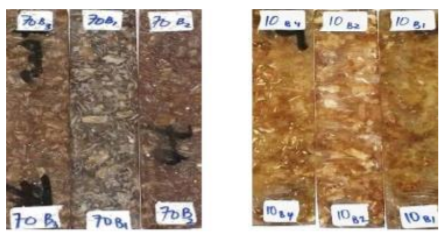Studi Pengaruh Komposisi Pengisi Serat Alam Kayu Galam (Melalueca Leucadendra) Bentuk Serutan pada Sifat Mekanik dan Mikrostruktur Komposit Poliester Sebagai Material Untuk Aplikasi Bilah Kincir Angin
Study of Composite Composition Effect of Natural Shavings of Galam Wood Fiber (Melalueca Leucadendra) on the Mechanical and Microstructure Properties of Polyester Composites as Materials for the Windmill Blades Application
DOI:
https://doi.org/10.25299/saintis.2019.vol19(1).2629Keywords:
Wind Energy, Windmill, Composite, Melaleuca leucadendra, PolyesterAbstract
[ID] Sebagai alternatif sumber energi konvensional, energi angin merupakan salah satu energi alternatif yang banyak dikembangkan. Pemanfaatan energi ini tidak lepas dari alat pengonversinya, kincir angin. Salah satu komponen kincir angin yang cukup penting adalah bilah. Bilah sering mengalami masalah berupa pengikisan pada bagian permukaannya akibat benturan dengan oleh partikel yang terbawa oleh angin yang dapat mengakibatkan fungsi bilah tidak optimal. Sehingga, dibutuhkan material pengganti yang lebih kuat tetapi ringan, yakni komposit. Komposit yang digunakan adalah komposit serat alam (serat Melaleuca leucadendra-poliester). Dalam penelitian ini akan dianalisa pengaruh fraksi volume serat berbentuk serutan terhadap kekuatan tarik, kelenturan dan ketangguhan. Pembuatan komposit serat alam Kayu Galam (Melaleuca leucadendra)-poliester dengan cara mencampurkan resin, katalis dan serat Kayu Galam yang berbentuk serutan kemudian dicetak didalam cetakan yang telah dilapisi alumunium foil. Sampel kemudian dilakukan pengujian kekuatan tarik dengan standar ASTM D 638, pengujian tekuk dengan standar ASTM D 790 serta pengujian impak dengan standar ASTM D 6110. Metode yang digunakan dalam pembuatan adalah metode hand lay-up. Hasil dari penelitian ini adalah nilai optimum yang dicapai yaitu 70% serat pada semua uji mekanik. Didapatkan nilai kekuatan tarik berada sebesar 13,07 MPa, kekuatan tekuk optimum 36,8 MPa dan nilai optimum dari kekuatan impak sebesar 590,39 MPa.
[EN] As an alternative to conventional energy sources, wind energy is one of the many alternative energies that have been developed. The utilization of this energy is inseparable from its conversion tool, windmills. One component of the windmill that is quite important is the blade. Blades often experience problems in the form of erosion on the surface due to collisions by particles carried by the wind which can cause the blade function to be not optimal. So, it takes a replacement material that is stronger but lighter, namely composite. The composites used were natural fiber composites (Melaleuca leucadendra-polyester fibers). In this study, the effect of the volume fraction of fiber in the form of shavings on tensile strength, flexibility, and toughness will be investigated. The making of natural fiber composites of Galam Wood (Melaleuca leucadendra) -polyester by mixing resin, catalyst, and Galam Wood fiber in the form of shavings is then printed in a mold that has been coated with aluminum foil. Samples were then tested for tensile strength with ASTM D 638 standard, bending test with ASTM D 790 standard and impact testing under ASTM D 6110 standard. The method used in manufacturing was the hand lay-up method. The result of this study is the optimum value achieved is 70% fiber in all mechanical tests. Obtained tensile strength values of 13.07 MPa, the optimum bending strength of 36.8 MPa and the optimum value of impact strength of 590.39 MPa.
Downloads
References
[2] Rachman, A. “Analisis dan Pemetaan Potensi Energi Angin di Indonesia”. Depok: Fakultas Teknik Program Studi Teknik Mesin. 2008.
[3] Kurniawan, D. “Unjuk Kerja Turbin Angin Propeller 4 Sudu Berbahan Komposit Berdiameter 100 cm dengan Lebar Maksimum Su”. Yogyakarta, Daerah Istimewa Yogyakarta, Indonesia. 2016.
[4] Nusantara, L. A. “Pengenalan Teknologi Pemanfaatan Energi Angin”. Tasikmalaya. 2014.
[5] Piggot, H. “Windpower Workshop: Building Your Own Wind Turbine”. Centre of Alternative Technologi Publication. 1997.
[6] Sagol, D. “Issues Concerning Roughness on Wind Turbine Blades”. Renewable and Sustainable Energy Review, 515-516. 2013.
[7] Kalagi, G. “Experimental Study on Mechanical Properties of Natural Fiber Reinforced Polymer Composite Materials for Wind Turbine Blades”. International Conference on Advanced Materials and Applications (p.2589). India: Materials Today Proceeding, 2016.
[8] Kretschmann, D.. General Technical Report. New York, 2000.
[9] Pandey, P., “Influence of Hybridizing Flax and Hemp-Agave Fibers with Glass Fiber as Reinforcement in a Polyurethane Composite”, 2016.
[10] Rahman, M., “Pengaruh Fraksi Volume Serat terhadap Peningkatan Kekuatan Impak Komposit Berpenguat Serat nanasnanasan( Bromeliaceae)Kontinyu Searah dengan Matriks Unsaturated polyester” . Jurnal Ilmiah Semesta Teknika Vol.13, No.2, 142, 2010.
[11] Djumharianto, D. (2014). “Pengaruh Persentase Massa Serat Terhadap Sifat Mekanis Komposit Matriks Polipropilen Dengan Penguat Serat Ampas Tebu Pada Proses Injection Molding”. Artikel Ilmiah Hasil Penelitian Mahasiswa Tahun 2014, 3.

Downloads
Published
Issue
Section
License

This work is licensed under a Creative Commons Attribution-ShareAlike 4.0 International License.
Copyright. This is an open access article which means that all content is freely available without charge to the user or his/her institution. Jurnal Saintis allows the author(s) to hold the copyright without restriction. The copyright in the text of individual articles (including research articles, opinion articles, and abstracts) is the property of their respective authors distributed under the terms of the Creative Commons Attribution-ShareAlike 4.0 International License which permits unrestricted use, distribution, and reproduction in any medium. Users are allowed to read, download, copy, distribute, search, or link to full-text articles in this journal without asking by giving appropriate credit, provide a link to the license, and indicate if changes were made.





